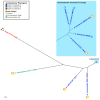Characterization of the Diversity in Host Range of an Extensively Drug-Resistant (XDR) Type IV Secretion System-Encoding Plasmid in Acinetobacter
- PMID: 40559614
- PMCID: PMC12196012
- DOI: 10.3390/pathogens14060606
Characterization of the Diversity in Host Range of an Extensively Drug-Resistant (XDR) Type IV Secretion System-Encoding Plasmid in Acinetobacter
Abstract
The World Health Organization (WHO) cites antimicrobial resistance as among the greatest threats to human health. The multidrug-resistant pathogen Acinetobacter baumannii, recognized as a priority pathogen for healthcare and research, is responsible for a diverse array of infections including respiratory tract, soft tissue and wound, and bloodstream infections. Despite this importance, the mechanisms of its pathogenesis remain poorly understood. Conjugation represents a central mechanism for bacterial adaptation and evolution and is responsible for the spread of genes that promote pathogen survival, antibiotic resistance, virulence, and biofilm formation. Our laboratory recently characterized a large group of almost 120 Type IV Secretion System (T4SS)-encoding plasmids in Acinetobacter, distributed globally across 20 countries spanning four continents, and demonstrated that an XDR A. baumannii plasmid from this family was transmissible to another A. baumannii strain. This research investigated the potential diversity of host strains for this representative member plasmid. Using the GC1 lineage strain A. baumannii AB5075-UW harbouring the XDR plasmid p1AB5075 and a series of previously characterized clinical and environmental Acinetobacter strains, conjugative analyses demonstrated transfer of the XDR plasmid to both A. baumannii strains of more genetically divergent sequence types and to non-baumannii Acinetobacter species both inside and outside the Acinetobacter calcoaceticus-baumannii (ACB) complex. Successful recipients included diverse strains of both clinical and environmental origin within the Acinetobacter genus. Collectively, this research could provide insights into an important genetic element for future surveillance.
Keywords: Acinetobacter baumannii; antibiotic resistance; bacterial pathogen; carbapenem resistance; conjugation; horizontal gene transfer; secretion system.
Conflict of interest statement
The authors declare no conflicts of interest regarding this publication.
Figures





Similar articles
-
Unravelling the genomic landscape of Acinetobacter baumannii: deep dive into virulence factors, resistance elements, and evolutionary adaptations.Mol Genet Genomics. 2025 Jul 12;300(1):68. doi: 10.1007/s00438-025-02265-3. Mol Genet Genomics. 2025. PMID: 40650755
-
Analysis of Acinetobacter P-type type IV secretion system-encoding plasmid diversity uncovers extensive secretion system conservation and diverse antibiotic resistance determinants.Antimicrob Agents Chemother. 2024 Dec 5;68(12):e0103824. doi: 10.1128/aac.01038-24. Epub 2024 Nov 4. Antimicrob Agents Chemother. 2024. PMID: 39494882 Free PMC article.
-
In silico and in vitro comparative analysis of 79 Acinetobacter baumannii clinical isolates.Microbiol Spectr. 2025 Jul;13(7):e0284924. doi: 10.1128/spectrum.02849-24. Epub 2025 May 16. Microbiol Spectr. 2025. PMID: 40377313 Free PMC article.
-
Prevalence of colistin resistance in clinical isolates of Acinetobacter baumannii: a systematic review and meta-analysis.Antimicrob Resist Infect Control. 2024 Feb 28;13(1):24. doi: 10.1186/s13756-024-01376-7. Antimicrob Resist Infect Control. 2024. PMID: 38419112 Free PMC article.
-
Overall status of carbapenem resistance among clinical isolates of Acinetobacter baumannii: a systematic review and meta-analysis.J Antimicrob Chemother. 2024 Dec 2;79(12):3264-3280. doi: 10.1093/jac/dkae358. J Antimicrob Chemother. 2024. PMID: 39392464
References
-
- World Health Organization . Global Priority List of Antibiotic-Resistant Bacteria to Guide Research, Discovery, and Development of New Antibiotics. WHO; Geneva, Switzerland: 2017.
-
- Ayobami O., Willrich N., Harder T., Okeke I.N., Eckmanns T., Markwart R. The incidence and prevalence of hospital-acquired (carbapenem-resistant) Acinetobacter baumannii in Europe, Eastern Mediterranean and Africa: A systematic review and meta-analysis. Emerg. Microbes Infect. 2019;8:1747–1759. doi: 10.1080/22221751.2019.1698273. - DOI - PMC - PubMed
MeSH terms
Substances
Grants and funding
LinkOut - more resources
Full Text Sources

